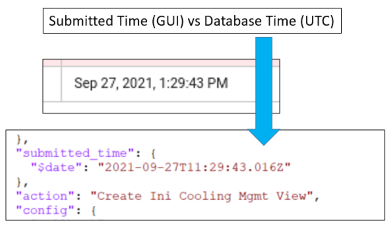Filtering Transactions¶
Overview¶
A transaction filter is a logical AND operation based on column values in the Transactions list, defined as search criteria on the Transaction Search Filter dialog.
Using Filters to Search for Transactions¶
Log in to the VOSS Automate Admin Portal.
Go to (default menu) Administration Tools > Transaction to open the Transaction log.
Note
In the classic Admin GUI, you can also open the Transaction log via the toolbar Notifications icon.
In the Admin Portal, you can also open the Transaction log via the toolbar Transaction Log icon.
On the Transactions list view, inspect the list of parent transactions. You can click on a parent transaction to view details of the parent and its sub transactions.
Open the search filter:
In the classic Admin GUI, to open the Transaction Search Filter dialog, either click the filter icon in the header row of the Id column, or click Filter at the bottom of the list.
In the Admin Portal, to open the Filter dialog, click the toolbar Filter icon.
In the Filter dialog, specify search criteria for the transaction/s you wish to view:
Field |
Description |
|---|---|
Transaction ID |
Options depend on whether you’re using the Admin Portal or the classic Admin GUI
|
Include Sub Transactions |
Apply filter criteria also to first level child transactions. Children of child transactions (sub-transactions directly below the parent) are excluded. By default, results show sub transactions above the parent (latest data on top) |
Exclude System Transactions |
Defines whether to exclude system-generated transactions (included by default); that
is, where the Username column value is |
Status |
Filter by transaction status. Options are: Any, Queued, Processing, Success, Success with Async Failures, or Fail. |
Field |
Description |
|---|---|
Date Range |
Predefined options are Last Day, Last Week, Last Month, or All. Alternatively, you can specify a custom date range. When selecting a quick filter (Last Day, Last Week, Last Month), the next time the filter is opened, the date selection displays as a Custom date range, since the range is then less than the selected interval. When choosing a Custom date range:
Note that when adding filter criteria for Username, Detail, or Message (legacy Admin GUI), filtering may be slower when the date range is greater than 7 days. The filter date/time is based on the browser local timezone, for example GMT+0200. This time is converted to the UTC standard as used in the database. (Time Conversion) |
Action |
Select an action to filter on, for example, |
Username |
Case-insensitive field to filter on values in the Username column. |
Detail |
Case-insensitive field to filter on values in the Detail column. |
Message |
Case-insensitive field to filter by text values in the Message column (legacy Admin GUI).
|
(Time Conversion)

Note
A filter timeout limits the filter search to 2 minutes. Try reducing the criteria to speed up filtering.
Once you’ve viewed filtered results, remember to cancel or clear the filter to display all transactions in the log. Filters are also cleared when you log out.
